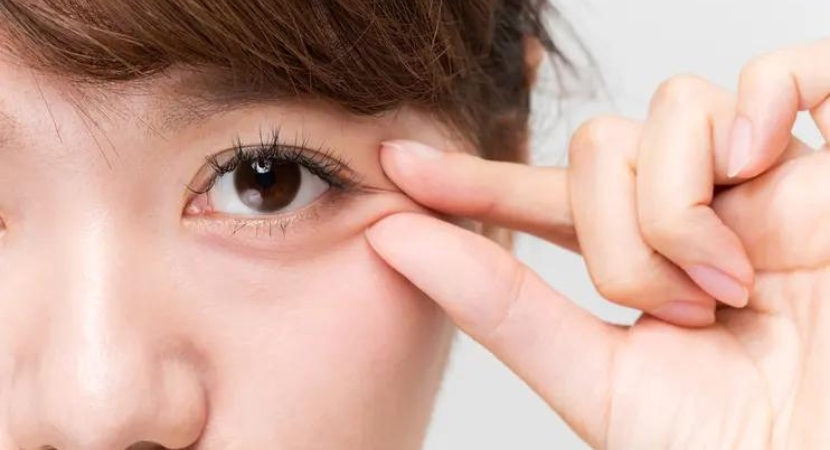
Canthoplasty is a cosmetic surgery that involves changing the angle of the eye. The phrase is derived from the Greek words "kanthos", meaning "corner of the eye", and "plasty", meaning "to shape".
Canthoplasty is a reconstructive surgical treatment performed to restore a drooping or sagging outer corner of the eye by raising the corner of the canthus to produce a larger and brighter appearing eye.
Dual Canthoplasty changes the vertical dimension of the eye, while epicanthoplasty and lateral canthoplasty change the horizontal dimension of the eye. Epicanthoplasty is a surgical treatment that enlarges the eye horizontally at the inner corner, while lateral canthoplasty enlarges the eye at the outer border. Adjusting the slope of the palpebral fissure by lateral canthoplasty can achieve widening of the eye width and smoother features, especially if the slope of the palpebral fissure is elevated and the horizontal dimension of the palpebral fissure is short.
Depending on the patient's condition, this treatment may be combined with additional surgeries such as double eyelid surgery, surgery to create an ocular slope, fat grafting, and forehead or facial bone contouring surgery to obtain even better results.

Anatomy of the lateral canthal region
The lateral canthal region under the skin consists of three parts: the lateral palpebral raphe (LPR), the superficial lateral palpebral ligament (SLPL), and the deep lateral palpebral ligament (DLPL). The LPR is formed when the lateral ends of the superior and inferior orbicularis oculi muscles intertwine at the lateral commissure.
The lateral palpebral ligament is divided into the SLPL and the DLPL. The SLPL extends from the lateral ends of the tarsal plate to the periosteum of the lateral orbital rim. The DLPL extends from the lateral margins of the tarsal plate deep to the origin of the SLPL to the tubercle of Whitnall on the zygomatic bone inside the orbital rim. The DLPL is attached to the lateral orbital tubercle (Whitnall's tubercle). Whitnall's tubercle is located 2.9-0.8 mm inside the orbital rim of the zygoma.
The SLPL must be incised and dissected to release the lateral canthus and allow for efficient handling while lateral canthoplasty is performed. It is not necessary to waste effort separating or dissecting the DLPL because it is deeply located and difficult to detect.
Dual Canthoplasty versus Blepharoplasty
The Dual Canthoplasty procedure should not be confused with lower eyelid blepharoplasty, which is a different form of eyelid surgery. Blepharoplasty removes extra skin, muscle, and perhaps fat from the lower or upper eyelid to make the eye look younger, although the surgery does not change the shape or size of the eye. In short, blepharoplasty removes "baggage."
A Dual Canthoplasty, on the other hand, is a cosmetic surgical technique that lifts the outer corner of the eye (the lateral canthus), reshapes the eye to a more almond shape, and increases eye opening. As a result, the eye appears brighter, larger and more alert.

Why do people undergo Canthoplasty?
People undergo canthoplasty for a number of reasons:
• Lower eyelid sagging (known as ectropion) - as we age, the skin and ligaments around our eyes lose elasticity, causing our lower eyelids to droop or sag, giving us a tired or sad look.
• Eye damage that causes the lower eyelid to droop or retract may need an eyelid lift to correct the imbalance of the outer corner of the eye.
• Dissatisfaction with a previous surgical result - Some canthoplasties are performed as revision surgery to correct lower eyelid problems caused by previous surgery, such as droopy lower eyelids or eversion abnormalities that reveal too much white of the eye (scleral show).
• Some patients seek canthoplasty surgery to achieve a more alveolar eye by lifting the oblique eyelid down and increasing the horizontal length of the eye.
Candidates for Dual Canthoplasty Surgery
Drooping of the outer corner of the lower eyelids is expected when the eyelids loosen with age. However, it can also be caused by skin tightening resulting from inadequate cosmetic surgery, UV damage and skin cancer surgery . Patients with droopy or baggy lower eyelids are often good candidates for this type of surgery, especially if the existing look and shape of the eye is stressing them out. When it comes to eyelid surgery, however, there is no one-size-fits-all approach, and what many patients believe they need may not be the type of surgical treatment that is best for them.
As a result, at the first consultation, the surgeon should carefully examine the function, tone and position of each patient's lower eyelid, as well as the overall shape of the face. In most cases, the surgeon will do this during consultations with patients who want to have blepharoplasty and may recommend canthal suspension (canthoplasty) at the same time.
In some cases, the surgeon may recommend an entirely different type of procedure that would be better suited to address the patient's concerns. It is crucial that canthoplasty surgery is only performed by an experienced, highly educated oculoplastic surgeon, as the consequences of improper surgery can be very difficult to recover from.
When you are admitted for the surgery, the surgeon will usually start by marking the eyes with a pen, where the incisions will be made after a thorough evaluation by a specialist, where they will look at the structure of the eyes and treatment alternatives. An anaesthetic will then be provided. This surgery is most often performed under local anesthesia.
How should I prepare?
In preparation for a Dual Canthoplasty, you may be asked to:
• Do laboratory tests or a medical evaluation.
• Take certain medications or adjust your current medications.
• Stop smoking.
• Avoid taking aspirin, anti-inflammatory medications, and herbal supplements, as they can increase bleeding and bruising.
Dual Canthoplasty should be performed in a hospital or certified office-based surgical facility. Make arrangements for a friend or family member to drive you to and from surgery, and to stay with you the first night after surgery.

The Dual Canthoplasty Procedure
The design of the surgery is very simple. Following the crease around the lateral canthus, the end point of the incision line is marked. At this time, the end point should not pass along the lateral wall of the bony orbit. Marking the lowest point of the bony orbit will help to locate the fixation point during surgery.
Local Infiltration
First, anesthetic eye drops (Alcaine 0.5%, proparacaine hydrochloride) are applied to the eye. An anesthetic containing 1:100,000 epinephrine mixed with a 1:1 solution of 0.5% bupivacaine hydrochloride and saline is injected using a 30 G 1/2 inch needle.
Incision and Dissection
Traction sutures are applied to the upper and lower eyelids before starting surgery. A skin incision is then made from the lateral canthus. After incision and dissection of the LPR and SLPL, the lower eyelid is gently pulled to check that it has become sufficiently relaxed. Care should be taken at this point not to damage the DLPL by excessively deep dissection. The critical area delineates a circle with a radius of 0.5 cm, and its center is located 30° inferior and lateral and 2.5 cm from the lateral canthus.
A cantoplexy is made in the periosteum and lower lid with a 6-0 nylon suture. Suturing is performed twice to ensure firm fixation, and the fixation site should be within 3 mm of the lower edge of the flap. Firm fixation should be applied on the inside of the lateral wall of the bony orbit when attaching to the periosteum to avoid problems such as lower eyelid eversion postoperatively.
Skin Closure
A skin suture was placed using 7-0 black silk. As the area of surgery is close to the eyeball, a soft thread should be used to reduce irritation to the eyeball.
Factors to consider after surgery:
• Oral antibiotics and ophthalmic ointment are recommended after surgery, as well as three types of eye drops (antibiotics, steroids and artificial tears). When the palpebral conjunctiva is swollen, steroid eye drops should only be taken for a short period of time. It is important not to open or massage the wound.
• While the patient may wash their face or take a light shower after the sutures are removed, they should wait three weeks before going to a sauna or swimming pool or using contact lenses.
Postoperative Progress
Stitches are removed five to seven days after surgery. Within one month after surgery, swelling is reduced by more than 90%. Palpebral conjunctival swelling and bloodshot eyes mostly disappear within three weeks. While the incision line may appear red for about two to three months, over time it blends in with the surrounding skin color and is no longer noticeable.

What happens after Dual Canthoplasty Surgery?
After treatment, your eyes are covered with a temporary protective covering. When you remove the protective eye shields after the procedure, you will notice that your vision is blurry. This is because antibiotic ointment is used to protect your eyes from drying out during surgery. To avoid infection, you will be given this ointment and instructed to put it in your eye and on your incision many times each day.
You will be instructed to bring someone to the surgery who will drive you home. It is recommended that someone stay with you for the first day or two after surgery, as you will be most comfortable with your eyes closed and protected by eye shields.
The recovery time for canthoplasty is comparable to other eyelid procedures, usually two to three weeks. Most patients have swelling and bruising that resolves within two weeks, but it may take a few weeks longer to fully resolve. Final results will be seen in a few months.
It is very important to follow your doctor's postoperative recommendations during this period to minimize problems and damage to the sensitive soft tissue around your eyes. In addition to artificial tears, you may be prescribed ointments or eye drops to prevent infection. Steroid eye drops may be needed to treat eye swelling.
Recovery may be uncomfortable at first. Your doctor may prescribe pain medication if needed. You can take paracetamol tablets to relieve pain. A small amount of blood is normal within the first 24 hours after surgery.
No bending, heavy lifting or strenuous exercise for 10 days. Swelling is natural and ranges from mild to severe. A cold compress should be used frequently during the first two days. Fill a clean dish half full of cold water, then soak and wring a clean face cloth in it. A face cloth should be used to cover the incision. Rinse the facecloth again with cold water when it is no longer cold. The cool compress will reduce swelling and soreness.
For at least one month after surgery, you should avoid taking showers, splashing your face, and wiping your eyes. Strenuous activity should be avoided for at least two weeks or until your doctor has seen you and confirmed that it is safe. Make-up is usually allowed after two weeks.
Pain, bruising and swelling are common after eye surgery, but these should subside in 7-14 days. Initially, keep your head upright and rest as much as possible. Patients should avoid exercise, rubbing the eyes, or applying makeup for two weeks.
People's vision may change under certain conditions, but this should only be temporary, with normal vision returning without medical intervention. Patients should avoid initiating strain on their eyes after surgery by not looking at their phones, reading or watching television. Contact lenses should be avoided for many weeks after surgery.
After Dual Canthoplasty surgery, full recovery usually takes 2-4 weeks, during which time it is critical to follow your surgeon's post-operative instructions and attend all scheduled follow-up appointments. A good surgeon will strive to make the scar less visible and covered by the natural crease of the eye.
In order to be performed properly, a canthoplasty needs a high degree of expertise and experience. Canthoplasty is considered a permanent means of repositioning the eyelids when performed by a highly skilled board certified oculoplastic surgeon and revision surgeries are rarely required.

Are there any Risks or Complications?
This technique should only be performed by specialists who have significant experience in oculoplastic surgery. When done poorly, the consequences can be severe.
Every procedure has some risk, although serious problems from canthoplasty are uncommon. Swelling and bruising are common in the first few weeks after surgery and usually resolve within two to three weeks. You may also experience dry eyes, excessive tearing and blurred vision in the weeks following surgery.
For this method, incisions are created on the outer surface of the lower eyelids. Complications are possible, although rare. Infection is always a risk, although it is uncommon after eyelid surgery. Although bleeding can occur and damage vision, it is relatively rare in laser surgery.
Damage to the muscle in the upper or lower eyelid can result in a droopy eyelid. Precautions are taken to avoid this, but if it does occur, it is repairable. Damage to the muscle in the lower eyelid can lead to double vision, but this is extremely uncommon.
Closing the eye can become difficult if too much skin is removed from the upper eyelid. Lower eyelid surgery causes the eyelid to sit away from the eye due to swelling, but this usually resolves quickly. Because the skin of the upper lid is incised, a scar may appear. The incision lies in the crease of the eyelid and will fade with time. However, if the scar is significant, it may become obvious and require repair.
Eyelid asymmetry is possible and may require treatment. The laser can cause harm if aimed directly at the eye. To prevent this, some surgeons use specially designed eye coatings. Some discomfort, swelling and perhaps bruising may occur; fluid may collect over the white of the eye and is usually transient. However, the use of a laser reduces this.
During your pre-operative appointment, your surgeon will discuss all the potential risks and complications of your surgical procedure in more detail. This information will also be provided in writing as part of the consent procedure for you to review.
Are the results of Canthoplasty permanent?
Canthoplasty needs a high degree of experience and knowledge to be performed properly. Canthoplasty is considered a permanent eyelid repositioning solution when performed by a highly competent board certified oculoplastic surgeon, and revision surgeries are rarely required.
Conclusion
The double canthoplasty, which combines an epicanthoplasty with a lateral canthoplasty, is for patients who wish to optimize the results of both procedures. The double canthoplasty will satisfy you if your eyes are short, narrow and slanted and you want to reduce the pointed glare.
Indications: This procedure is recommended if you have the Mongolian fold, have a limited field of vision, want to increase the length of the horizontal and vertical lines of the eyes.
Surgical time: 30 minutes ~ 1 hour
Anesthesia: Local anesthesia or hypnoanesthesia (twilight anesthesia)
Suture removal: After 5 days and 9 days
After surgical examinations: Twice
Time to resume daily activity: None


